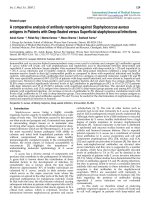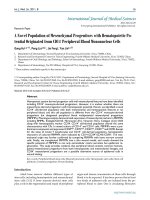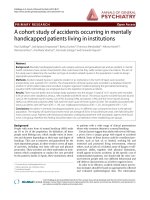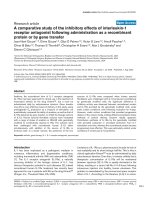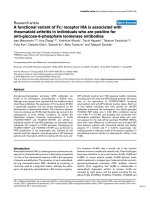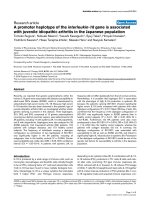Báo cáo y học: " A patient with bacteraemia and possible endocarditis caused by a recently-discovered genomospecies of Capnocytophaga: Capnocytophaga genomospecies AHN8471: a case report" potx
Bạn đang xem bản rút gọn của tài liệu. Xem và tải ngay bản đầy đủ của tài liệu tại đây (302.19 KB, 5 trang )
BioMed Central
Page 1 of 5
(page number not for citation purposes)
Journal of Medical Case Reports
Open Access
Case report
Cervical necrotising fasciitis and descending mediastinitis
secondary to unilateral tonsillitis: a case report
Asad Islam* and Michael Oko
Address: Pilgrim hospital, Sibsey road, Boston, Lincolnshire, PE21 9QS, UK
Email: Asad Islam* - ; Michael Oko -
* Corresponding author
Abstract
Introduction: Cervical necrotizing fasciitis is an aggressive infection with high morbidity and
mortality. We present a case of cervical necrotizing fasciitis and descending mediastinitis in a
healthy young man, caused by unilateral tonsillitis with a successful outcome without aggressive
debridement.
Case presentation: A 41-year-old man was admitted to our unit with a diagnosis of severe acute
unilateral tonsillitis. On admission, he had painful neck movements and the skin over his neck was
red, hot and tender. Computed tomography scan of his neck and chest showed evidence of cervical
necrotizing fasciitis and descending mediastinitis secondary to underlying pharyngeal disease. He
was treated with broad-spectrum intravenous antibiotics. His condition improved over the next 3
days but a tender and fluctuant swelling appeared in the suprasternal region. A repeat scan showed
the appearance of an abscess extending from the pretracheal region to the upper mediastinum
which was drained through a small transverse anterior neck incision. After surgery, the patient's
condition quickly improved and he was discharged on the 18th day of admission.
Conclusion: Less invasive surgical techniques may replace conventional aggressive debridement
as the treatment of choice for cervical necrotizing fasciitis and descending necrotizing mediastinitis.
Introduction
Cervical necrotizing fasciitis (CNF) is an uncommon but
aggressive infection with high morbidity and mortality.
We present a case of CNF and descending mediastinitis in
a healthy young patient, caused by unilateral tonsillitis,
with a successful outcome involving simple incision and
drainage. We discuss the importance of a computerised
tomography (CT) scan in making an early diagnosis. We
also review the possible role of less aggressive surgical
techniques in the management of CNF.
Case presentation
A 41-year-old man was admitted with a 3-day history of
severe sore throat and painful swallowing. According to
him, it started as a mild sore throat but rapidly worsened
despite taking oral penicillin for 3 days from his general
practitioner (GP). There was no significant past medical
history. On examination, his temperature was 38.3°C and
he was tachycardic (102/min). His neck movements were
markedly restricted by pain and he had a spiking fever.
The skin on the front of his neck was red, hot and tender
down to his clavicles, with no evidence of localised swell-
ing or ischaemia/necrosis. Oral examination showed a
Published: 4 December 2008
Journal of Medical Case Reports 2008, 2:368 doi:10.1186/1752-1947-2-368
Received: 29 January 2008
Accepted: 4 December 2008
This article is available from: />© 2008 Islam and Oko; licensee BioMed Central Ltd.
This is an Open Access article distributed under the terms of the Creative Commons Attribution License ( />),
which permits unrestricted use, distribution, and reproduction in any medium, provided the original work is properly cited.
Journal of Medical Case Reports 2008, 2:368 />Page 2 of 5
(page number not for citation purposes)
markedly inflamed right tonsil covered with patchy grey
exudate. There was no clinical evidence of peritonsillar
abscess. The left tonsil appeared remarkably normal. Flex-
ible nasendoscopy showed normal epiglottis and larynx.
Blood tests revealed leukocytosis of 22.3 × 10
9
cells/L and
a high C-reactive protein (CRP) of 421 mg/L.
A lateral X-ray of his neck showed air and swelling in the
pretracheal soft tissues and loss of normal cervical lordo-
sis. These findings prompted an urgent CT scan of his neck
and chest, which demonstrated air shadows and diffuse
swelling and enhancement of cervical fascia extending
from skull base to upper mediastinum. Similar changes
were also seen in the pretracheal soft tissue (figures 1, 2
and 3).
Throat swabs and blood cultures were sent for microbiol-
ogy and intravenous (I.V.) therapy with broad spectrum
antibiotics was commenced as it was decided to initially
Sagittal reconstruction of CT of the neck and upper mediastinum; extensive soft tissue abnormality (swelling and surgical emphysema) in the retropharynx with loss of normal fat plane with the prevertebral space and possible communication with the oropharynxFigure 1
Sagittal reconstruction of CT of the neck and upper mediastinum; extensive soft tissue abnormality (swelling and surgical
emphysema) in the retropharynx with loss of normal fat plane with the prevertebral space and possible communication with
the oropharynx. Air (arrows) is also present in the pretracheal tissue and extends into the upper mediastinum.
Journal of Medical Case Reports 2008, 2:368 />Page 3 of 5
(page number not for citation purposes)
2a: Horizontal CT view of the neck at the level of suprasternal notch; the surgical emphysema and soft tissue swelling (arrows) is seen in the pretracheal region and prevertebral space and is extending beyond the carotid sheathsFigure 2
2a: Horizontal CT view of the neck at the level of suprasternal notch; the surgical emphysema and soft tissue swelling (arrows)
is seen in the pretracheal region and prevertebral space and is extending beyond the carotid sheaths. In 2b (after 3 days of anti-
biotic therapy), the appearance of the disease process has changed (in comparison to 2a) with a decreasing amount of air in the
soft tissues and replacement by an abscess (arrows) which has irregular enhancing margins.
Journal of Medical Case Reports 2008, 2:368 />Page 4 of 5
(page number not for citation purposes)
treat the condition medically. Surgical debridement was
not carried out at this stage because there was no skin
necrosis and no collection was shown by the CT scan.
His general condition showed improvement. His temper-
ature came down and his oral intake improved but over
the next 3 days a tender and fluctuant swelling appeared
in the suprasternal region with diffuse margins.
A repeat CT scan of the neck and chest at this stage showed
receding air shadows and the appearance of an abscess
extending from the pretracheal region to the upper medi-
astinum. After discussions with a radiologist it was
decided to carry out a limited surgery in the form of inci-
sion and drainage. About 200 ml of pus was drained via a
small transverse suprasternal incision and midline split of
the abscess wall. All the loculi were broken down with a
finger. Cultures of the pus did not reveal any organisms.
After surgery, the patient's condition dramatically
improved. Drains from the wound were removed on the
fifth postoperative day and the wound was allowed to
heal by secondary intention. Inflammatory markers pro-
gressively came back to normal and the patient was dis-
charged on the 18th day after admission. He was followed
up after 2 weeks with a repeat CT scan which showed com-
plete resolution. He underwent "interval tonsillectomy"
in our department and the tonsils were sent for histopa-
thology which did not reveal any abnormal findings.
Discussion
Necrotizing fasciitis (NF) is a fulminant infection that
affects the deep and superficial fascia while initially spar-
ing the overlying skin and underlying muscle. The most
common sites for NF to occur are the abdomen, extremi-
ties and perineum. It is uncommon in the cervicofacial
area and the usual nidus of infection in these cases is the
teeth. The presence of immuno-compromising conditions
Horizontal CT view of the neck at the level of suprasternal notch (about 6 weeks after surgery)Figure 3
Horizontal CT view of the neck at the level of suprasternal notch (about 6 weeks after surgery). This shows complete resolu-
tion of the inflammatory process.
Journal of Medical Case Reports 2008, 2:368 />Page 5 of 5
(page number not for citation purposes)
predisposes to CNF as well as increases morbidity and
mortality [1]. Peritonsillar abscess is a rare but recognized
cause of this condition [2,3]. However, tonsillitis in our
patient was not complicated by a peritonsillar abscess.
Moreover, the tonsillitis was unilateral in our patient and
none of the known causes of unilateral tonsillitis were
found in him.
Soft tissue X-ray of the neck is a useful initial investigation
in less suspicious cases and it can detect air in the soft tis-
sues [3]. However, in suspicious cases, one should have a
low threshold for performing a CT scan. The role of the CT
scan in CNF is twofold, namely, to help establish the diag-
nosis at an early clinical stage and to help detect compli-
cations due to progressive tissue necrosis after initial
surgical management. The most common CT findings in
CNF are the thickening and infiltration of subcutaneous
tissues, fluid collection in multiple neck compartments
and diffuse enhancement and thickening of the cervical
fascia, platysma and sternocleidomastoid and strap mus-
cles. Inconsistent features include gas collection in the soft
tissues [4,5]. In this case, none of the specimens grew any
organisms. This was probably because the patient had
started using antibiotics 3 days before admission. How-
ever, empirical antibiotics were chosen on the basis of
well known synergism between aerobes and anaerobes
[1,6,7]. Historically, early and sometimes multiple, radi-
cal debridement has remained the cornerstone in the
management of this condition [1,3,8]. But two large stud-
ies done at Osaka University medical school in Japan
recently reported that percutaneous catheter drainage as a
novel treatment for CNF and descending necrotizing
mediastinitis is less invasive than conventional surgical
drainage and produced a similar outcome. Moreover, per-
cutaneous catheter drainage areas are less likely to become
secondarily infected by antibiotic-resistant bacteria, and it
seems superior to surgical drainage in pain control and in
preventing protein leakage from the wound [9,10].
Although the treatment strategy in our case was not
exactly the same, we successfully avoided aggressive deb-
ridement. We suggest that there is certainly a place for less
invasive surgical management in the treatment of CNF
and mediastinitis but more research is needed to fully
evaluate the effectiveness and suitability of less invasive
treatment strategies.
Conclusion
CNF is being increasingly reported from across the world.
One should have a low threshold for CT scan in suspi-
cious cases due to its easy and quick availability in most
centres. Minimally invasive surgical techniques like percu-
taneous catheter drainage may replace conventional surgi-
cal drainage as the treatment of choice for CNF and
descending necrotizing mediastinitis. More studies are
needed to evaluate these novel treatments.
Abbreviations
CT: computerised tomography; CRP: C-reactive protein;
CNF: cervical necrotising fasciitis; GP: General Practi-
tioner; I.V.: intravenous
Consent
Written informed consent was obtained from the patient
for publication of this case report and any accompanying
images. A copy of the written consent is available for
review by the Editor-in-Chief of this journal.
Competing interests
The authors declare that they have no competing interests.
Authors' contributions
AI wrote the abstract, case summary, literature review and
discussion for this case report and arranged CT pictures.
MO was the clinician responsible for the overall care of
the patient and helped to draft the manuscript. Both
authors read and approved the final manuscript.
References
1. Skorina J, Kaufman D: Necrotizing fasciitis originating from
pinna perichondritis. Otolaryngol Head Neck Surg 1995,
113:467-473.
2. Losanoff JE, Missavage AE: Neglected peritonsillar abscess
resulting in necrotizing soft tissue infection of the neck and
chest wall. Int J Clin Pract 2005, 59:1476-1478.
3. Zilberstein B, de Cleva R, Testa RS, Sene U, Eshkenazy R, Gama-Rod-
rigues JJ: Cervical necrotizing fasciitis due to bacterial tonsilli-
tis. Clinics 2005, 60:177-182.
4. Becker M, Zbären P, Hermans R, Becker CD, Marchal F, Kurt AM,
Marré S, Rüfenacht DA, Terrier F: Necrotizing fasciitis of the
head and neck: role of CT in diagnosis and management.
Radiology 1997, 202:471-476.
5. Wysoki MG, Santora TA, Shah RM, Friedman AC: Necrotizing fas-
ciitis: CT characteristics. Radiology 1997, 203:859-863.
6. Edwards John D, Sadeghi Nader, Najam Farzad, Margolis Mark:
Craniocervical necrotizing fasciitis of odontogenic origin
with mediastinal extension. Ear Nose Throat J 2004, 83:579-582.
7. Maisel RH, Karlen R: Cervical necrotizing fasciitis. Laryngoscope
1994, 104:795-798.
8. Mohammedi I, Ceruse P, Duperret S, Vedrinne J, Boulétreau P: Cer-
vical necrotizing fasciitis: 10 years' experience at a single
institution. Intensive Care Med 1999, 25:829-834.
9. Sumi Y, Ogura H, Nakamori Y, Ukai I, Tasaki O, Kuwagata Y, Shimazu
T, Tanaka H, Sugimoto H: Nonoperative catheter management
for cervical necrotizing fasciitis with and without descending
necrotizing mediastinitis. Arch Otolaryngol Head Neck Surg 2008,
134:750-756.
10. Nakamori Y, Fujimi S, Ogura H, Kuwagata Y, Tanaka H, Shimazu T,
Ueda T, Sugimoto H: Conventional open surgery versus percu-
taneous catheter drainage in the treatment of cervical
necrotizing fasciitis and descending necrotizing mediastini-
tis. AJR Am J Roentgenol 2004, 182:1443-1449.
